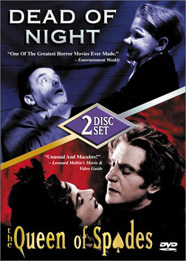
QUEEN OF SPADES
UK, 1949, 95 minutes, Black and white.
Anton Walbrook, Edith Evans, Yvonne Mitchell, Ronald Howard, Mary Jerrold, Anthony Dawson, Miles Malleson, Michael Medwin, Athene Seyler.
Directed by Thorold Dickinson.
The Queen of Spades is a striking melodramatic ghost story. It is an adaptation of a story by Russian writer, Pushkin.
Edith Evans portrays an old countess who enters into a Faustian bargain with the Devil in order to win at cards to which she is addicted. She encounters a military captain, played by Anton Walbrook, who is also addicted to gambling and who murders the countess for her secret. He is then haunted by her ghost.
The film capitalises on its sets and décor, black and white interiors in Russian period drama. The acting is also very strong. Anton Walbrook had appeared in many significant British films of the 40s including The Life and Death of Colonel Blimp and The Red Shoes. Edith Evans, a noted stage actress at the time, began her film career and made her mark in such films as The Importance of Being Earnest as Lady Bracknell as well as Bryan Forbes’ The Whisperers. Yvonne Mitchell was to emerge as a strong character actress in films of the 1950s.
The film was directed by writer-director Thorold Dickinson who made a number of films in the 1930s. He continued during the 1940s but made only two films in the 1950s. His first film was an adaptation of School for Scandal. In 1940 he made the first version of Gaslight and directed John Gielgud in 1941 in The Prime Minister.
1. What was the overall impact of this film? How enjoyable, how interesting, instructive, impressive?
2. The continental flavour of the film? The Russian flavour? And yet the film being British? Comment on the flavour gained by the use of sets, black and white photography, music, light and darkness, angle photography, flashbacks, shock editing, ghostly atmosphere? How did they combine in an impressive film?
3. The title of the film and the theme, the explanation of superstition and evil? The film as a parable, the hero as Everyman? the occult, power, love and lust, exploitation, haunting, disillusionment, death? These themes as illustrated by old Russia?
4. How interesting was the period and its portrait in the film? The contrived background from the introduction of old St Petersburg, the world aristocracy, dancing and deaths, cards and castles, old books and the occult, society? How did this add to the intensity of the parable
5. The film's comment on St Petersburg code of behaviour, honour, good and evil?
6. Did the audience sympathize with the hero? His initial stand-off, the revelation of his resentment, hidden obsessions, infatuation with the gypsies, the effect of this experience on him, his hovering over the book, his selling his soul, his using Liza, the possibility of redemption by love and yet his using her, his pride and arrogance, his co-operation, the horror of his killing the countess, greed overpowering him, relentlessness, success and then a failure? The meaning of his life?
7. The queen of Spades as evil, destructive, superstitious? The queen of spades as a projection of interior evil?
8. The contrast of Liza, simple, dominated by the countess, serving the countess, possibility of romantic love, infatuation, ignoring warnings, the letters, - suffering the utter disillusionment?
9. The countess as an image of the hero the importance of the flashbacks of the story, seeing her in old age, the desperation of her prayer, her wanting to be saved, her not revealing the suddenness of her death, the importance of her ghostly appearances? What insight into a greedy woman?
10. The importance of the background characters like the countess's grandson and his gambling, the other gamblers?